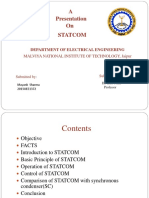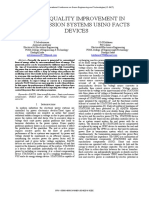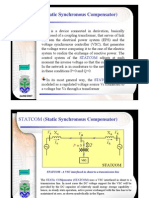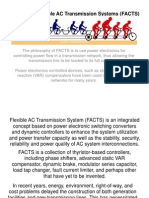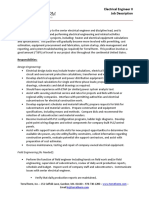(RL Loading) Wind Generator Based Statcom
Uploaded by
Kumar Madhu(RL Loading) Wind Generator Based Statcom
Uploaded by
Kumar MadhuWIND GENERATOR BASED STATCOM IMPLEMENTED AT
INDUSTRIAL POWER LAB, NIT CALICUT
Theory:
A static synchronous compensator (STATCOM), also known as a "static synchronous
condenser" (STATCON), is a shunt connected FACTS device which uses force commutated
power electronics(GTO, IGBT etc.) to inject reactive current into a power system for the purpose of
controlling system voltage or power factor. It is based on a power electronics voltage source
converter and can act as either a source or sink of reactive AC power to an electrical network.
If connected to a source of power it can also provide active AC power.
STATCOM is basically a voltage source converter (VSC) that converts a dc voltage at
its input terminals into three phase ac voltages at fundamental frequency of controlled
magnitude and phase angle. VSCs use pulse width modulation (PWM) technology, which
makes it capable of providing high quality ac output voltage to the grid or even to a passive
load. STATCOM provides shunt compensation in a similar way as static VAR compensator
but utilizes a voltage source converter rather shunt capacitors and reactors. The basic principle
of operation of a STATCOM is the generation of a controllable AC voltage source behind a
transformer leakage reactance by a voltage source converter connected to a DC capacitor. The
voltage difference across the reactance produces active and reactive power exchanges between
the STATCOM and the power system.
Unlike SVC, STATCOM controls the output current independently of the AC system
voltage, while the DC side voltage is automatically maintained to serve as a voltage source.
Mostly, STATCOM is designed based on the voltage source inverter. Also, the combination of
STATCOM with a different storage device or power source endows the STATCOM the ability
to control the real power output.
Managed by IPA Group Under the leadership of Dr. Ashok S
Usually a STATCOM is installed to support electricity networks that have a poor power
factor and often poor voltage regulation. The reactive power at the terminals of the STATCOM
depends on the amplitude of the voltage source. For example, if the terminal voltage of the
VSC is higher than the AC voltage at the point of connection, the STATCOM generates
reactive current; on the other hand, when the amplitude of the voltage source is lower than the
AC voltage, it absorbs reactive power. The response time of a STATCOM is shorter than that
of an SVC, mainly due to the fast switching times provided by the IGBTs of the voltage source
converter.
In the transmission systems, STATCOMs primarily handle only fundamental reactive
power exchange and provide voltage support to buses by modulating bus voltages during
dynamic disturbances in order to provide better transient characteristics, improve the transient
stability margins and to damp out the system oscillations due to disturbances. The point of
compensation can be sending end, midpoint or receiving end. Midpoint compensation is the
most preferred one for transmission lines which results in improved voltage profile, reduced
losses and increased transmission capability.
In distribution system, medium and low voltage STATCOM is employed mainly for
Reactive power support at the load points.
Harmonic control for nonlinear loads.
In addition, static synchronous compensators are installed in select points in the power
system to perform the following:
Voltage support and control
Voltage fluctuation and flicker mitigation
Unsymmetrical load balancing
Power factor correction
Active harmonics cancellation
Improve transient stability of the power system
Components of the system
i. Artificial Transmission Line Model.
Type : 3 Phase Pi equivalent Model.
Operating voltage : 220 V line to line.
Current Rating : 2.5 A.
Short Circuit Strength : 5 A.
Line Simulation through iron cored inductor. Each Pi section for 30km.
ii. Microcontroller based charger for battery.
Micro controller based buck boost converter with MPPT algorithm.
IGBT switches.
Input voltage 350-400 V.
iii. Battery Bank for 3 phase set up.
Managed by IPA Group Under the leadership of Dr. Ashok S
Low maintenance tubular batteries/ maintenance free.
For 1 kW: 12V/42 Ah – a set of 25 Nos.
Total battery delivery capacity: 325 V/ 42 Ah.
iv. Source Inverter: A voltage source inverter based converter fed from battery bank
with only magnitude control
v. STATCOM Inverter: A voltage source inverter with control over both magnitude
and angle of injection.
vi. R-L /R-C load.
Basic Principle of Operation
In the case of two AC sources, which have the same frequency and are connected
through a series reactance, the power flows will be:
Active or Real Power flows from the leading source to the lagging source.
Reactive Power flows from the higher to the lower voltage magnitude source.
Consequently, the phase angle difference between the sources decides the active power
flow, while the voltage magnitude difference between the sources determines the reactive
power flow. Based on this principle, a STATCOM can be used to regulate the reactive power
flow by changing the output voltage of the voltage-source converter with respect to the system
voltage.
Modes of Operation
The STATCOM can be operated in two different modes:
A. Voltage Regulation
The static synchronous compensator regulates voltage at its connection point by
controlling the amount of reactive power that is absorbed from or injected into the power
system through a voltage-source converter.
In steady-state operation, the voltage V2 generated by the VSC through the DC capacitor is
in phase with the system voltage V1 (δ=0), so that only reactive power (Q) is flowing (P=0).
• From a DC input voltage source, provided by the charged capacitor CS, the converter
produces a set of controllable three-phase output voltages with the frequency of
the ac power system. Each output voltage is in phase with, and coupled to the
corresponding ac system voltage via a relatively small (0.1-0.15 p.u.) tie reactance
(which in practice is provided by the per phase leakage inductance of the coupling
transformer).
• By varying the amplitude of the output voltages produced, the reactive power
exchange between the converter and the ac system can be controlled in a manner
similar to that of the rotating synchronous machine.
Managed by IPA Group Under the leadership of Dr. Ashok S
• That is, if the amplitude of the output voltage is increased above that of the ac
system voltage, then the current flows through the tie reactance from the converter
to the ac system, and the converter generates reactive (capacitive) power for the
ac system.
• If the amplitude of the output voltage is decreased below that of the ac system,
then the reactive current flows from the ac system to the converter, and the
converter absorbs reactive (inductive) power. If the amplitude of the output voltage
is equal to that of the ac system voltage, the reactive power exchange is zero.
Subsequently, the amount of reactive power flow is given by the equation:
Q = [V1 (V1-V2)] / X
B. VAR Control
In this mode, the STATCOM reactive power output is kept constant independent of
other system parameter
STATCOM V-I characteristic
Managed by IPA Group Under the leadership of Dr. Ashok S
Experimental Setup:
Managed by IPA Group Under the leadership of Dr. Ashok S
Connection Diagram:
Managed by IPA Group Under the leadership of Dr. Ashok S
REACTIVE POWER COMPENSATION OF A
TRANSMISSION LINE USING STATCOM
Aim:
1. To study the Wind Generator based STATCOM set up for power factor compensation
of a transmission line module.
2. To adjust the midpoint compensation given by STATCOM to improve the receiving
end power factor of the transmission line to unity for a different loading conditions.
3. Compare the voltage regulation of the uncompensated and compensated lines.
Procedure:
For Battery Charging
1. Check the voltage rating of series connected battery bank.
2. From the solar cell wiring panel, connect the required number of solar panels in series
so that the total output voltage is 10 – 20% more than the voltage rating of battery
bank. The voltage rating of each solar panel is 90 volts.
3. Now connect the output terminals of solar cell wiring panel to the input terminals of
the battery charger. Connect the output terminals of battery charger to the battery
bank through an ammeter.
4. Switch on the battery charger, reset the protection circuit on it and check the DC rail
voltage. Switch on the MCB on the battery charger.
5. Switch on the DSPIC based PWM generator and increase the duty ratio of PWM
signal to vary the charging current.
STATCOM
1. Turn on the power supply to source, battery charger and STATCOM.
2. Check whether any protection circuit is activated, and reset it.
3. Check the DC rail voltage for the battery charger.
4. Turn on the DSP kit and select STATCOM operation using the switch SW2 on it.
5. Switch on MCB 1.
6. Adjust the sending end voltage to 110 V (line to neutral) using switches SW1 and SW2
on the interface board and note down the voltage, current, power factor, active power
and reactive power at the receiving end for the applied load.
7. Increase the STATCOM modulation index to 80% using switches SW3 and SW4 on
the interface board.
8. Switch on MCB 2 and note down the sending end and receiving end parameters.
9. Adjust the angle of STATCOM using the switches SW2 and SW3 on the DSP kit to
improve the sending end and receiving end power factor.
10. Note down the voltage, current, power factor, active power and reactive power at both
the ends.
Managed by IPA Group Under the leadership of Dr. Ashok S
11. Switch off MCB 2 and MCB 1.
12. Reset the DSP kit and repeat the procedure for different R-L loading conditions.
Results:
Managed by IPA Group Under the leadership of Dr. Ashok S
Observations:
A) Power Factor Compensation
i. Inductive Loading = _____%
Quantity Without STATCOM With STATCOM
Voltage (V)
Current (A)
Active Power (kW)
Reactive Power (kVAR)
Power Factor
Phase Angle of STATCOM = _____
Reactive power supplied by STATCOM = _______ kVAR.
ii. Inductive Loading = _____%
Quantity Without STATCOM With STATCOM
Voltage (V)
Current (A)
Active Power (kW)
Reactive Power (kVAR)
Power Factor
Phase Angle of STATCOM = _____
Reactive power supplied by STATCOM = _______ kVAR.
iii. Inductive Loading = _____%
Quantity Without STATCOM With STATCOM
Voltage (V)
Current (A)
Active Power (kW)
Reactive Power (kVAR)
Power Factor
Phase Angle of STATCOM = _____
Reactive power supplied by STATCOM = _______ kVAR.
Managed by IPA Group Under the leadership of Dr. Ashok S
iv. Inductive Loading = _____%
Quantity Without STATCOM With STATCOM
Voltage (V)
Current (A)
Active Power (kW)
Reactive Power (kVAR)
Power Factor
Phase Angle of STATCOM = _____
Reactive power supplied by STATCOM = _______ kVAR.
B) Voltage Regulation
Sending End Voltage = 110V.
Receiving End Voltage Voltage Regulation
Inductive
Loading Without With Without With
STATCOM STATCOM STATCOM STATCOM
100%
80%
60%
40%
Managed by IPA Group Under the leadership of Dr. Ashok S
You might also like
- Solutions To Homework 1: (A) (B) (C) (D) (E) (A) (B) (C) (D) (E)100% (1)Solutions To Homework 1: (A) (B) (C) (D) (E) (A) (B) (C) (D) (E)8 pages
- Journal of Borderland Research - Vol XLVI, No 2, March-April 199075% (4)Journal of Borderland Research - Vol XLVI, No 2, March-April 199032 pages
- Power Quality Improvement of Distribution System Using D-STATCOMNo ratings yetPower Quality Improvement of Distribution System Using D-STATCOM11 pages
- Voltage Stability With The Help of STATCOMNo ratings yetVoltage Stability With The Help of STATCOM6 pages
- Static Synchronous Compensator (Statcom)No ratings yetStatic Synchronous Compensator (Statcom)11 pages
- Lecture 5 - Role of Inverter in MicrogridNo ratings yetLecture 5 - Role of Inverter in Microgrid45 pages
- A Presentation On Reactive Power Compensation: BY K.S.S Venkata Satya Naveen S.Manoj KumarNo ratings yetA Presentation On Reactive Power Compensation: BY K.S.S Venkata Satya Naveen S.Manoj Kumar26 pages
- Performance Analysis of 48-Pulse VSC-Based STATCOM in Mitigation of Voltage Dip Caused by The Starting of A High Power Induction-MotorNo ratings yetPerformance Analysis of 48-Pulse VSC-Based STATCOM in Mitigation of Voltage Dip Caused by The Starting of A High Power Induction-Motor5 pages
- A New Control Scheme For Power Quality Improvement With StatcomNo ratings yetA New Control Scheme For Power Quality Improvement With Statcom7 pages
- Simulation and Comparison of UPFC Using Matlab: Vikas Goyal, Prof. Khulsum AslamNo ratings yetSimulation and Comparison of UPFC Using Matlab: Vikas Goyal, Prof. Khulsum Aslam4 pages
- Shunt Compensation For Power Quality Improvement Using A Statcom ControllerNo ratings yetShunt Compensation For Power Quality Improvement Using A Statcom Controller5 pages
- Reactive Power High-Voltage Electricity Transmission (1) (2) Flexible AC Transmission SystemNo ratings yetReactive Power High-Voltage Electricity Transmission (1) (2) Flexible AC Transmission System11 pages
- By:-S.Shivaprasad N.Swathireddy T.Ramu RanjankumarNo ratings yetBy:-S.Shivaprasad N.Swathireddy T.Ramu Ranjankumar36 pages
- Voltage Support Control Strategies For Static Synchronous Compensators Under Unbalanced Voltage SagsNo ratings yetVoltage Support Control Strategies For Static Synchronous Compensators Under Unbalanced Voltage Sags4 pages
- Single Phase Statcom - Its Control Algorthim: Linju JoseNo ratings yetSingle Phase Statcom - Its Control Algorthim: Linju Jose4 pages
- Presented By: Sibaram Padhy Konark Institute of Science and Technology (Kist) REGD NO:-0801214280No ratings yetPresented By: Sibaram Padhy Konark Institute of Science and Technology (Kist) REGD NO:-080121428016 pages
- Reactive Power Control Through STATCOM - Prajeet100% (1)Reactive Power Control Through STATCOM - Prajeet8 pages
- Power Factor Correction: Ch.V.Sesha Girirao Associate Professor EEE DepartmentNo ratings yetPower Factor Correction: Ch.V.Sesha Girirao Associate Professor EEE Department33 pages
- Presentation About Statcom: Submitted By:-Md Nasim LE-21156No ratings yetPresentation About Statcom: Submitted By:-Md Nasim LE-211568 pages
- Assignment No_03_FACTS Devices_by Muzammil and kashifNo ratings yetAssignment No_03_FACTS Devices_by Muzammil and kashif9 pages
- Optimal Location of Statcom For Power Flow ControlNo ratings yetOptimal Location of Statcom For Power Flow Control5 pages
- Static Synchronous Compensator STATCOM FNo ratings yetStatic Synchronous Compensator STATCOM F6 pages
- Unit 3 Reactive Power - Voltage ControlNo ratings yetUnit 3 Reactive Power - Voltage Control38 pages
- Improvement of Power Quality in Distribution System Using D-STATCOM With PI and PID ControllerNo ratings yetImprovement of Power Quality in Distribution System Using D-STATCOM With PI and PID Controller7 pages
- A STATCOM Simulation Model To Improve VoNo ratings yetA STATCOM Simulation Model To Improve Vo5 pages
- Simulation of D STATCOM To Study Voltage PDFNo ratings yetSimulation of D STATCOM To Study Voltage PDF3 pages
- Simulation of Some Power Electronics Case Studies in Matlab Simpowersystem BlocksetFrom EverandSimulation of Some Power Electronics Case Studies in Matlab Simpowersystem BlocksetNo ratings yet
- Simulation of Some Power Electronics Case Studies in Matlab Simpowersystem BlocksetFrom EverandSimulation of Some Power Electronics Case Studies in Matlab Simpowersystem BlocksetNo ratings yet
- Some Power Electronics Case Studies Using Matlab Simpowersystem BlocksetFrom EverandSome Power Electronics Case Studies Using Matlab Simpowersystem BlocksetNo ratings yet
- Reference Guide To Useful Electronic Circuits And Circuit Design Techniques - Part 1From EverandReference Guide To Useful Electronic Circuits And Circuit Design Techniques - Part 12.5/5 (3)
- Detailed Notification New India Assurance Assistant PostsNo ratings yetDetailed Notification New India Assurance Assistant Posts2 pages
- Unit-Iv Stability Analysis: 1. What Is BIBO Stability?No ratings yetUnit-Iv Stability Analysis: 1. What Is BIBO Stability?4 pages
- Section 20. Electrical and Electronic Symbols 11-.271GENERAL. The Electrical and 11-.272SYMBOLS. Only Those SymbolsNo ratings yetSection 20. Electrical and Electronic Symbols 11-.271GENERAL. The Electrical and 11-.272SYMBOLS. Only Those Symbols14 pages
- Phytoremediation 150123100305 Conversion Gate02No ratings yetPhytoremediation 150123100305 Conversion Gate0249 pages
- Class 12 Physics Competency Based Question Bank 4 Moving Charges and MagnetismNo ratings yetClass 12 Physics Competency Based Question Bank 4 Moving Charges and Magnetism142 pages
- Unit 2 Notes-1 - Magnetic & DielectricsNo ratings yetUnit 2 Notes-1 - Magnetic & Dielectrics23 pages
- Mock Test 10 (Hints & Solution) Prayas JEE 2.0 2024No ratings yetMock Test 10 (Hints & Solution) Prayas JEE 2.0 202414 pages
- LDRP Institute of Technology and Research Electrical Engineering DepttNo ratings yetLDRP Institute of Technology and Research Electrical Engineering Deptt3 pages
- DLP_4THQ_SCIENCE-9_FEB11_INTRODUCTION TO FORCE, MOTION, AND ENERGYNo ratings yetDLP_4THQ_SCIENCE-9_FEB11_INTRODUCTION TO FORCE, MOTION, AND ENERGY2 pages
- Electricity Generation From Speed Breakers 2016No ratings yetElectricity Generation From Speed Breakers 20165 pages
- HV Transformers Factory Test Oct 8 9 PDFNo ratings yetHV Transformers Factory Test Oct 8 9 PDF27 pages
- Content of Report Investigation of The Stepper MotorNo ratings yetContent of Report Investigation of The Stepper Motor12 pages
- Surge Transfer Through 3-Phase Transformers Hileman1958No ratings yetSurge Transfer Through 3-Phase Transformers Hileman19589 pages
- Practical Guide: This Practical Guide Contains Important Information About Your PracticalNo ratings yetPractical Guide: This Practical Guide Contains Important Information About Your Practical11 pages
- Engineering Physics Model Question Paper 2 2018 PDFNo ratings yetEngineering Physics Model Question Paper 2 2018 PDF2 pages
- Transmission Line Fault Analysis by Using Matlab Simulation: Shyamveer Rajput - Dr. K.T. ChaturvediNo ratings yetTransmission Line Fault Analysis by Using Matlab Simulation: Shyamveer Rajput - Dr. K.T. Chaturvedi3 pages
- Part I: Introduction and Basic Concepts: 1.1 Definition Fluid MechanicsNo ratings yetPart I: Introduction and Basic Concepts: 1.1 Definition Fluid Mechanics18 pages
- Solutions To Homework 1: (A) (B) (C) (D) (E) (A) (B) (C) (D) (E)Solutions To Homework 1: (A) (B) (C) (D) (E) (A) (B) (C) (D) (E)
- Journal of Borderland Research - Vol XLVI, No 2, March-April 1990Journal of Borderland Research - Vol XLVI, No 2, March-April 1990
- Power Quality Improvement of Distribution System Using D-STATCOMPower Quality Improvement of Distribution System Using D-STATCOM
- A Presentation On Reactive Power Compensation: BY K.S.S Venkata Satya Naveen S.Manoj KumarA Presentation On Reactive Power Compensation: BY K.S.S Venkata Satya Naveen S.Manoj Kumar
- Performance Analysis of 48-Pulse VSC-Based STATCOM in Mitigation of Voltage Dip Caused by The Starting of A High Power Induction-MotorPerformance Analysis of 48-Pulse VSC-Based STATCOM in Mitigation of Voltage Dip Caused by The Starting of A High Power Induction-Motor
- A New Control Scheme For Power Quality Improvement With StatcomA New Control Scheme For Power Quality Improvement With Statcom
- Simulation and Comparison of UPFC Using Matlab: Vikas Goyal, Prof. Khulsum AslamSimulation and Comparison of UPFC Using Matlab: Vikas Goyal, Prof. Khulsum Aslam
- Shunt Compensation For Power Quality Improvement Using A Statcom ControllerShunt Compensation For Power Quality Improvement Using A Statcom Controller
- Reactive Power High-Voltage Electricity Transmission (1) (2) Flexible AC Transmission SystemReactive Power High-Voltage Electricity Transmission (1) (2) Flexible AC Transmission System
- By:-S.Shivaprasad N.Swathireddy T.Ramu RanjankumarBy:-S.Shivaprasad N.Swathireddy T.Ramu Ranjankumar
- Voltage Support Control Strategies For Static Synchronous Compensators Under Unbalanced Voltage SagsVoltage Support Control Strategies For Static Synchronous Compensators Under Unbalanced Voltage Sags
- Single Phase Statcom - Its Control Algorthim: Linju JoseSingle Phase Statcom - Its Control Algorthim: Linju Jose
- Presented By: Sibaram Padhy Konark Institute of Science and Technology (Kist) REGD NO:-0801214280Presented By: Sibaram Padhy Konark Institute of Science and Technology (Kist) REGD NO:-0801214280
- Power Factor Correction: Ch.V.Sesha Girirao Associate Professor EEE DepartmentPower Factor Correction: Ch.V.Sesha Girirao Associate Professor EEE Department
- Presentation About Statcom: Submitted By:-Md Nasim LE-21156Presentation About Statcom: Submitted By:-Md Nasim LE-21156
- Assignment No_03_FACTS Devices_by Muzammil and kashifAssignment No_03_FACTS Devices_by Muzammil and kashif
- Optimal Location of Statcom For Power Flow ControlOptimal Location of Statcom For Power Flow Control
- Improvement of Power Quality in Distribution System Using D-STATCOM With PI and PID ControllerImprovement of Power Quality in Distribution System Using D-STATCOM With PI and PID Controller
- Simulation of Some Power Electronics Case Studies in Matlab Simpowersystem BlocksetFrom EverandSimulation of Some Power Electronics Case Studies in Matlab Simpowersystem Blockset
- Simulation of Some Power Electronics Case Studies in Matlab Simpowersystem BlocksetFrom EverandSimulation of Some Power Electronics Case Studies in Matlab Simpowersystem Blockset
- Some Power Electronics Case Studies Using Matlab Simpowersystem BlocksetFrom EverandSome Power Electronics Case Studies Using Matlab Simpowersystem Blockset
- Reference Guide To Useful Electronic Circuits And Circuit Design Techniques - Part 1From EverandReference Guide To Useful Electronic Circuits And Circuit Design Techniques - Part 1
- Detailed Notification New India Assurance Assistant PostsDetailed Notification New India Assurance Assistant Posts
- Unit-Iv Stability Analysis: 1. What Is BIBO Stability?Unit-Iv Stability Analysis: 1. What Is BIBO Stability?
- Section 20. Electrical and Electronic Symbols 11-.271GENERAL. The Electrical and 11-.272SYMBOLS. Only Those SymbolsSection 20. Electrical and Electronic Symbols 11-.271GENERAL. The Electrical and 11-.272SYMBOLS. Only Those Symbols
- Class 12 Physics Competency Based Question Bank 4 Moving Charges and MagnetismClass 12 Physics Competency Based Question Bank 4 Moving Charges and Magnetism
- Mock Test 10 (Hints & Solution) Prayas JEE 2.0 2024Mock Test 10 (Hints & Solution) Prayas JEE 2.0 2024
- LDRP Institute of Technology and Research Electrical Engineering DepttLDRP Institute of Technology and Research Electrical Engineering Deptt
- DLP_4THQ_SCIENCE-9_FEB11_INTRODUCTION TO FORCE, MOTION, AND ENERGYDLP_4THQ_SCIENCE-9_FEB11_INTRODUCTION TO FORCE, MOTION, AND ENERGY
- Content of Report Investigation of The Stepper MotorContent of Report Investigation of The Stepper Motor
- Surge Transfer Through 3-Phase Transformers Hileman1958Surge Transfer Through 3-Phase Transformers Hileman1958
- Practical Guide: This Practical Guide Contains Important Information About Your PracticalPractical Guide: This Practical Guide Contains Important Information About Your Practical
- Engineering Physics Model Question Paper 2 2018 PDFEngineering Physics Model Question Paper 2 2018 PDF
- Transmission Line Fault Analysis by Using Matlab Simulation: Shyamveer Rajput - Dr. K.T. ChaturvediTransmission Line Fault Analysis by Using Matlab Simulation: Shyamveer Rajput - Dr. K.T. Chaturvedi
- Part I: Introduction and Basic Concepts: 1.1 Definition Fluid MechanicsPart I: Introduction and Basic Concepts: 1.1 Definition Fluid Mechanics
















